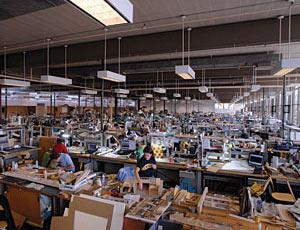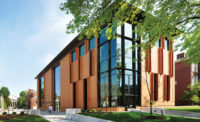|
|
When the industry is slow—and even when it isn’t—the best work happens in the classroom, a safe space for architectural experimentation since at least the École des Beaux Arts. The problem is, except for a digitally generated blip in the 1980s, students have been stuck experimenting in a vacuum, changing the system on paper and computer screens, but not in reality. That’s the argument that Monica Ponce de Leon, founder and principal of Office dA, brought to her new job as dean of the University of Michigan’s Taubman College of Architecture and Urban Planning.
Known for work that is both environmentally focused, like the eco-friendly LA gas station, the Helios House, and digitally informed, like the rippling wood GSD offices, Ponce de Leon just completed her first academic year at the school, where she has begun to implement a radical, interdisciplinary approach to architectural education. She spoke with William Bostwick about how new technology and a post-crash global consciousness should change the way we teach.
William Bostwick: What made you want to run an architecture school?
Monica Ponce de Leon: The field of architecture is stagnating—we’re at a crossroads. First, the issue of environmental degradation is really prevalent in other fields, but not in architecture school. We should be leading the conversation, but we’re following. Second, I think we’re entering a second digital revolution. When I started school in the ’80s, everything was done by hand, and when I left it was all digital. It changed the way we design—it enabled all those dramatic geometries of the last 20 years. Now, digital tools are affecting manufacturing. Mill shops use digitally guided tools; classical moldings are cut with lasers or water jets. We should be preparing our students to build with these methods. I hope we don’t repeat the ’80s, arguing whether it’s a good thing or not.
WB: You’re proposing an interdisciplinary program. How does it work?
MPL: Working across disciplines brings together experts from environmental engineering, mechanical engineering, sustainable technology. Take our environmental technology courses. Some of these classes don’t have a single faculty member, but are co-taught. For example, we have paired a pilot studio class with a lecture course in structures.

WB: So the courses are similar? You’re not going to pair a studio with, say, music theory?
MPL: We might. We’re looking at urban planning, government, social studies, environmental technology, history, theory… Architecture doesn’t exist in a vacuum, but in school it often does.
WB: What about design-build programs? Those are usually presented as a way to give architectural education a real-world context.
MPL: They have some value, but it’s limited intellectually because it means that education follows practice. Education can’t take a critical approach to practice, can’t change practice, because it’s mimicking it. Plus, a studio lasts three months, but in the real world, a project is a year or longer. You’re pretending to engage, but you’re not. Practical experience is important, but pedagogy shouldn’t revolve around it.
WB: The first digital revolution came during a recession like this one, which led to a lot of wild experimentation in lieu of actual building—architects like Bernard Tschumi, Greg Lynn, Hani Rashid. Will this new manufacturing technology mean similar experimentation?
MPL: During the first digital revolution, we looked inward, saying, “This is what architecture can do,” demonstrating our abilities. I’m hoping that this time we take stock of the new economy, the fact that we’ve been left out of discussions of national policy, infrastructure, and housing. That should give us pause. Architecture has engaged with narrow problems and failed to engage with the world at large. We should test our boundaries—how do we address other issues besides architecture, how do we engage with society? There’s a thought that if you’re interested in form and digital technology, you’re somehow not engaged with society…
WB: …And that all socially conscious architecture has some kind of hand-made, craft feeling to it.
MPL: Right. So I’m hoping we can use this technology to be limber and succeed in the greater social agenda.
WB: For example?
MPL: Buildings play a huge role in environmental degradation, with the destruction of the landscape, but also the destruction of materials. So this is a way to take a critical look at how we fabricate buildings, and it’ll help us address some of those issues.
WB: In five years or so, when your first class of students graduates and starts building projects, what will their work look like?
MPL: My generation was extremely entrepreneurial. When I came into the industry, construction was dismal here [in the United States], especially compared to Europe, so we had to invent new kinds of projects that we could actually build. So we did a lot of salons, restaurants… These were areas where architecture was not thought to have a place. I hope [contemporary students] build on that, and look at design broadly, working across new fields, and bringing design lessons to new places.
WB: Is this new job related to slowdowns at your office?
MPL: The economy’s affecting us, but we’re continuing to produce. We have offices in Ann Arbor, Boston, and New York. My partner Nader Tehrani teaches at MIT, and since the beginning, I’ve worked full time in practice and fulltime in education. I don’t think of them as separate endeavors. They’re interrelated. What we do in our practice we bring to academia, and vice versa. Working in academia makes you realize that design isn’t just about solving a problem for the client. The moves you make aren’t just between you, the client, and the site—they belong to a much larger system.


